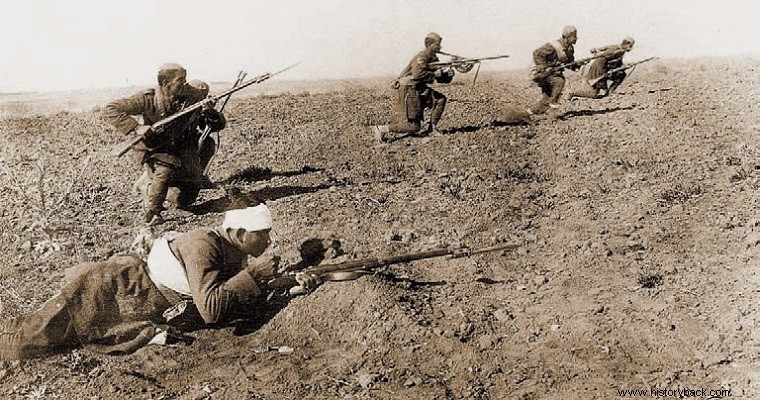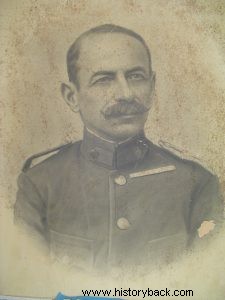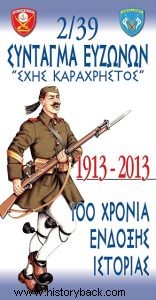
In 1867, in the small and poor village of Chalkiopoulos in Etoloakarnania, a boy from a large family saw the light of day for the first time. This boy was named Vlasius and he was to give his name – his surname to be exact – to a hill in the depths of Asia Minor several years later.
He entered the NCO Preparatory School on 1 October 1884 and graduated two years later with the rank of sergeant. The Greek Army during this period in many cases existed only in name, with the majority of men absent from the units on long-term leaves, with meager equipment, mediocre training and anything but ingrained discipline.
Under these conditions, Vlasis remained for 10 years at the rank of sergeant and only on March 1, 1896 was he promoted to the rank of corporal and assigned to the 6th Infantry Regiment of the 1st Brigade of the Epirus Army.
There he was found by the outbreak of the war of 1897. He particularly distinguished himself in the battle of Anogeio - Hani Karvasara, stubbornly holding the positions in Hani Karvasara, on April 17, 1897, although the Turks had thrown very strong forces into the sector.
Later the Greek forces attacked against the Turks, invading the still Turkish occupied part of Epirus. The great battle was fought in Gribovo (May 1-3, 1897), where the 6th Regiment distinguished itself fighting the Turkish 2nd Infantry Division.
The Regiment, guarded by the III/6th Infantry Battalion, succeeded in breaking through the Turkish defensive position manned by four battalions and driving the Turks into disorderly flight. Sergeant Karachristos was again among the distinguished.
That war ended, as is well known, with the defeat of Greece. Few military personnel were rescued from the wreckage. Karachristos was among them and was even promoted to the rank of second lieutenant for his action. Like all Greek officers, he also felt deep bitterness for the defeat by the eternal enemy, for the humiliation of the Greek Army and the country in general.
However, events took their course. In 1909 the movement exploded in Goudi and a little later El. Venizelos assumed the prime ministership of the country. At the same time, the army was being reorganized and strengthened, in view of the new confrontation with the Turks.
In the meantime Karachristos, one of the few heroes of the "unfortunate" war of 1897, had been promoted in 1901 to second lieutenant and in 1908 to lieutenant. With this rank, the outbreak of the First Balkan War in October 1912 found him commanding an infantry company of the 6th Regiment. At the head of the company he took part in the battle of Sarandaporos.
The III Division to which the regiment belonged had undertaken the mission of breaking up the Turkish position in the village of Sarandaporo. With courage and momentum the divisional infantry charged despite the difficult terrain and heavy Turkish artillery fire and managed to reach within 600 meters of the main Turkish defense line. The next day Sarandaporo fell and the advance continued. The fierce battle of Giannitsa and the liberation of Thessaloniki followed.
But the war was not over and the Greek army turned towards western Macedonia and after defeating the Turks again in the battle of Arnissa, liberated Florina and Kastoria. Karachristos participated in these operations and again distinguished himself in the battles in Ag. Paraskevi of Edessa, in Hieropigi of Florina and in Biglitsa and Krystalopigi.
It was then that Lieutenant Karachristos set foot on the soil of Northern Epirus for the first time, when the III Division crossed the Devolis River, after first crushing the Turkish resistance in the battles in the villages of Bratsani and Kurila.
After the victory, the 6th Infantry Regiment remained in the village of Kourila, reinforced with mountain artillery, forming the stable bodyguard of the Greek army that continued its advance. The III Division, a few days later, liberated Kortsa for the first time.
After the liberation of the Ioannina people, the war against Turkey ended, but the Second Balkan War broke out shortly after, when the Bulgarians suddenly attacked their allies until then.
Karachristos found himself in battle again, first in the great and bloody battle of Kilkis and then in the pursuit of the Bulgarians and in the battles of the Straits of Kresna and Tzoumaia - Oniar Mahala. In the latter, he especially showed extraordinary bravery, personally leading the attack of his company against the Bulgarians who were pressing hard on the Greek front.
The end of the Balkan Wars found Greece almost doubled in size, with a large part of the Greek territories liberated. However, the Northern Continent was not only not assigned to her, but with the help of our Italian "friends", the state of Albania was created, to which this Greek region was also annexed. The people of North Epirus asked for the assistance of the Venizelos government, but it was not given to them.
So they began to fight alone against the Albanians. Karachristos enlisted as a volunteer in the Delvinos Regiment, whose organization he undertook. He even distinguished himself in the battle of Tsepou Monastery (1914), saving Argyrokastro from the enraged Albanians. This fact was the beginning of the disfavor he fell into by the Venizelics.
The Northern Continental Rebellion had its well-known outcome and the embittered captain returned home in 1914. The following year he was named major. Externalizing his bitterness towards Venizelos and his stance on the Northern Continental issue, Karachristos sided, during the Schism, in favor of King Constantine. In 1917 he was promoted to lieutenant-colonel, but after the rise of Venizelos he was expelled from the army and was dishonorably discharged in 1918, without even joining the ranks of the reserve.
The blow for him, a soldier who had given everything to Greece, was heavy. However, his retirement lasted only two years. In 1920 Venizelos was defeated in the elections and the new government reinstated King Constantine. Under these circumstances, in 1920, he returned to the army with the rank of colonel, which was given to him retroactively.
Immediately after his recall to service he assumed command of the 37th Infantry Regiment of the III Division in Asia Minor. However, the victories of the Greek Army in the battles of Eski Sehir - Kiutachia - Afion Karahisar did not ensure the success expected by the Greek administration, since the Turks retreated behind Sangarios and organized new lines of defense. The Greek administration decided to attack the new Turkish positions with the aim of capturing Ankara, the last logistics base of the Turks.
The advance east of Sangario was particularly difficult. Karachristos was now in command of the 2/39 Evzones Messolonghi Regiment, his "own" children. The attack towards Ankara and towards victory, as the Greeks believed, began successfully, despite the fierce reaction of the Turks. On August 18, 1921, the 3rd Division, part of the 3rd Army Corps, was fighting fiercely against the Turks in the area of Karakogio. The Division attacked with two regiments, the 2/39 Evzones on the right and the 12th on the left.
And the 2/39 occupied the fortified hill, northeast of the village of Karakoyou, charging out with the lance and capturing four Turkish cannons and other material. On the left, the 12th Infantry Regiment succeeded in capturing the village of the same name. However, the Turks were reinforced in the evening and threw the 61st Infantry Division and the elite 5th Caucasus Division into battle against the two Greek regiments. Fatefully, the Turkish counterattack succeeded and the Greek forces were pushed back.
However, the battle for the hill was not over. On August 20, the III Division, with the same arrangement as before, attacked again. In 2/39 he undertook the rough task of excavating the organized stony hill of Karakogio. The ground was completely uncovered and the Turkish artillery was pounding furiously.
The Euzonians charged but heavy enemy fire forced them to fall back to their lines of attack. There the divisions were reorganized, in the presence of colonel Karachristos.
Immediately afterwards the trumpets signaled "Advance-advance" and the Euzonians with their lances outstretched again rushed forward. This time they managed to get through the Turkish barrier, reach the fortified hill and with their momentum break through the Turkish defense lines and capture the site.
However, the Turks had strong reserves and immediately launched a strong counter-attack, recapturing the stony hill, which was now red with blood. Karachristos immediately regrouped his divisions and attacked.
The Euzones of 2/39 occupied the hill again. A fresh Turkish counter-attack threatened to throw them back again, but they held their ground at the foot, and with Karachristos, literally, at their head, the men charged once more towards the blood-stained summit.
Body to body, with weapons, hands, feet, with kicks and punches, with teeth still, Greeks and Turks were enthralled. One by one the Turkish trench lines fell, at a heavy price. Karachristos was there, among his men. Suddenly in the midst of the battle the colonel staggered, fell.
The hill was finally captured and Galanolefki was erected in honor on it. The blood toll was heavy. In addition to Karachristos, another 29 officers and 534 soldiers fell in the battle. In this place of sacrifice the glorious dead were buried.
Karachristos slept there, among his men, dying like a soldier, as he lived all his life. In his honor, the murderous hill was named "Karachristou Hill", being just a lost toponym in the depths of Anatolia now... After his death, many years later, he was promoted to lieutenant general. The 2/39 Evzones Regiment, from 2000 until its abolition in 2018, bore his name.

Colonel Karachristos.

Poster for the 100th anniversary of the establishment of the 2/39 Constitution, in 2013.
PANTELIS D. KARYKAS
